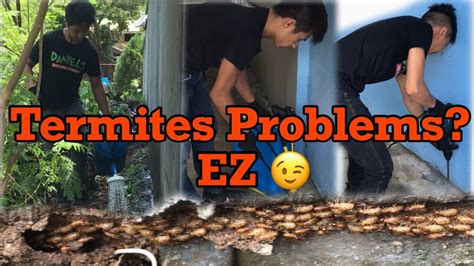How to Get Rid of Anay: A Comprehensive Guide
Anay, or subterranean termites, are a destructive pest that can cause significant damage to your property. Knowing how to get rid of them effectively is crucial to protecting your home and investment. This comprehensive guide provides practical steps and preventative measures to help you eliminate these pests and prevent future infestations.
Identifying an Anay Infestation
Before you start treatment, it's essential to confirm you're dealing with anay. Misidentifying the pest can lead to ineffective treatment. Look for these signs:
- Mud tubes: These are characteristic shelter tubes made of mud, wood, and excrement, often found on walls, foundations, and under structures. They're a strong indicator of anay activity.
- Damaged wood: Anay infestations often result in damaged wood, which may sound hollow when tapped. Look for pinpoint holes or wood that crumbles easily.
- Swarmers: During swarming season, winged reproductives (alates) may appear. These are dark-bodied insects, about ½ inch long, with two pairs of equal-sized wings.
Important Note: If you're unsure, consult a professional pest control service. They have the expertise to correctly identify the pest and recommend the appropriate treatment.
Effective Methods to Eliminate Anay
Getting rid of anay requires a multi-pronged approach that combines preventative measures with targeted treatments.
1. Professional Pest Control
This is often the most effective method. Professional pest control companies have access to powerful termiticides and the expertise to apply them correctly. They'll also conduct a thorough inspection to identify the extent of the infestation. They may employ methods like:
- Liquid Termiticides: These are injected into the soil around the foundation to create a barrier that kills anay as they attempt to cross.
- Baiting Systems: These involve placing bait stations containing a slow-acting insecticide that attracts and eliminates the colony over time. This is often a more environmentally friendly option.
- Fumigation: In severe cases, fumigation may be necessary. This involves sealing the structure and introducing a gas that kills the anay.
2. Preventative Measures
Preventing future infestations is just as crucial as eliminating existing ones. Consider these steps:
- Maintain proper drainage: Excessive moisture attracts anay. Ensure proper grading and drainage around your foundation to prevent water accumulation.
- Reduce wood-to-soil contact: Keep wood elements like decking and fence posts away from direct contact with the ground.
- Regular inspections: Regularly inspect your property for signs of anay activity, especially in vulnerable areas like basements and crawl spaces. Early detection is key to effective control.
- Wood Treatment: Treat wood used in construction with a preservative to deter anay.
3. DIY Treatments (Use with Caution)
While professional treatment is strongly recommended, some DIY methods can supplement professional efforts or be used for minor infestations:
- Borate Treatments: Borate-based solutions can be applied to wood to make it less palatable to anay. However, this is often not effective for large infestations.
Important Disclaimer: DIY methods are generally not as effective as professional treatments, and improper application can be ineffective or even harmful. Always prioritize professional help for significant infestations.
Conclusion: Protecting Your Home from Anay
Protecting your home from anay requires vigilance and proactive measures. While DIY methods may play a supporting role, professional pest control remains the most reliable method for eliminating these destructive pests. Regular inspections, preventative measures, and timely professional intervention are key to safeguarding your property and its value. Don't hesitate to seek professional help at the first sign of infestation.
